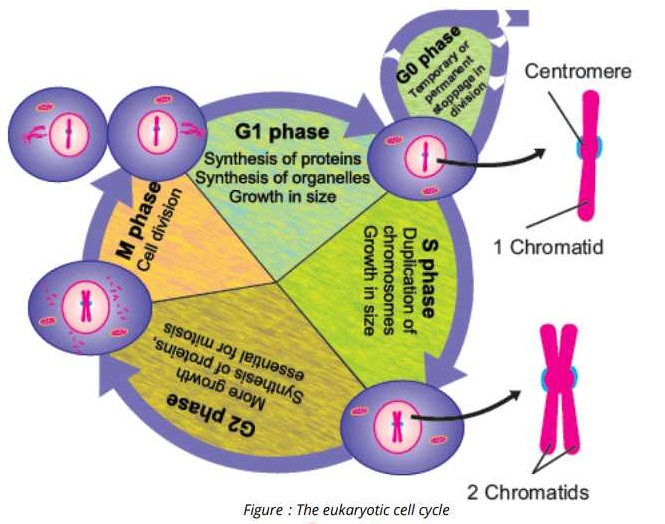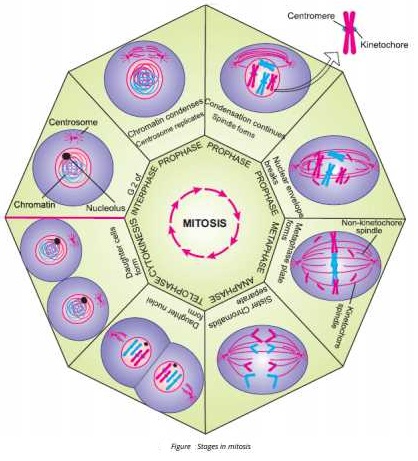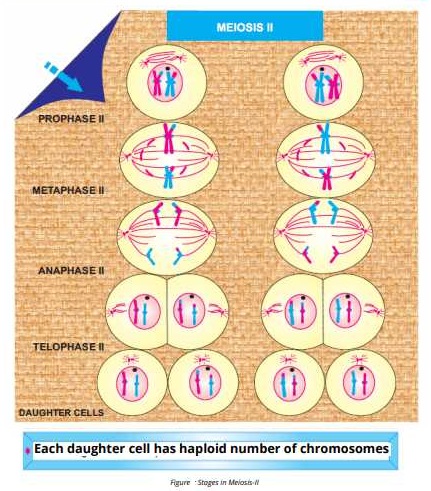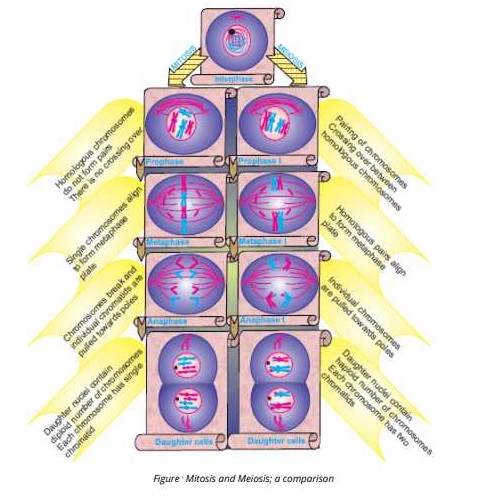Unit 5 – Cell Cycle (Exercise Questions)
ANSWER THE FOLLOWING QUESTIONS
Q.1. What is cell cycle and what are its main phases?
Q.2. The S-Phase of Interphase is important and a cell never divide without it. Justify.
Q.3. How would you state the events of prophase?
Q.4. Make a list of the events of mitosis.
Q.5. How is mitosis significant?
Q.6. Describe the events that occur during the phases of meiosis-I.
Q.7. Describe the significance of meiosis.
Q.8. Contrast mitosis and meiosis, emphasizing the events that lead to different outcomes.
Q.9. Make a list of the events of mitosis.
SHORT QUESTIONS -TEXT EXERCISE
Q.1. A nerve cell does not divide after its formation. In which phase of cell cycle it is?
Q.2. How is cytokinesis different in plant cells as compared 10 animals cell?
Q.3. What type of cell division occurs when our wounds are healed?
Q.4. Plants do not make their gametes by meiosis. How is that?
Q.1. What is cell cycle and what are its main phases?
Answer:
CELL CYCLE
Cell Cycle is the sequence of events in the life of a cell from the time a cell is produced until it completes mitosis and – produces new cells. The eukaryotic cell cycle consists of two major phases -i.e. Interphase and
Mitotic phase (M phase) also called cell division.
INTERPHASE:
It is the period between cell divisions, during which the cell acquires nutrients from its environment, grows, and replicates its chromosomes. The cell biologist divided Interphase into three sub phases .i.e. GI, S and G2.
(i) G1 Phase:
This is called as the First Gap. After its production, a cell starts its cell cycle in G1 phase.
Events:
• Cell increases its supply of proteins.
• Cell increases the number of its organelles (mitochondria, ribosomes)
• Cell grows in size.
• Synthesis of various enzymes required in the S Phase, for the duplication of chromosomes.
(ii) S Phase:
This phase is the Synthesis Phase. Event:
• Cell duplicates its chromosomes as a result, each chromosome consists of two sister
chromatids.
(iii) G2 Phase:
This phase is called as the Second Gap.
Event:
• Cell prepares proteins that are essential for mitosis, mainly for the production of spindle fibers.
Inhibition of Protein Synthesis:
Inhibition of protein synthesis during G2 phase prevents cell from undergoing mitosis.
Duration:
Typically, the Inter phase lasts for at least 90% of the total time required for the cell cycle.
2. M Phase:
After the G2 phase of Inter phase, the cell enters the division phase, i.e. M Phase. It is characterized by mitosis, in which cell divides into the two daughter cells.

GO Phase:
In multicellular eukaryotes, cells enter GO phase from G1 and stop dividing.
Permanent GO Phase:
Some cells remain in GO phase for an indefinite period of time.
Example:
Neurons
Semi-permanent GO Phase:
Some cells enter GO phase semi-permanently.
Example:
Some cells of liver and kidney
No GO Phase:
Many cells do not enter GO Phase and continue to divide throughout an organism’s life.
Example:
Epithelial cells.
Important:
The events of cell cycle are ordered and directional i.e. each event occurs in a sequential fashion and it is impossible to “Reverse” the cycle.
Q.2. The S-Phase of Interphase is important and a cell never divide without it. Justify.
Answer:
S phase (DNA Synthesis Phase)
Chromosome replication occurs in this phase. Each chromosome is duplicated as a result each chromosome consists of two sister chomratids, which contains identical genes. During S phase, animal cells also duplicate their centrioles.
Q.3. How would you state the events of prophase?
Answer:
Karyokinesis involves division of nucleus, following events occur during this process;
1. Division of Centriole:
The partition of Centriole takes place, which have been duplicated during Interphase but were in the same Centrosome.
2. Formation of Mitotic Apparatus:
The specialized microtubule structure including aster & spindle is called.
Mitotic Apparatus
It is specially designed to attach and capture chromosomes, align them and finally separating them so that equal distribution of chromosome is ensured.
STAGES / TEPS OF KARYOKINESIS:
Karyokinesis can further be divided into following stages,
(i) Prophase (ii) Metaphase
(iii) Anaphase, (iv) Telophase
PROPHASE
It is. the phase in which:
> Chromatin material is appeared.
> Nucleoli are disappeared.
> Cytoplasm becomes more viscous.
During Interphase (non-dividing) of the cell cycle the chromosomes are not visible but using histologic stains for DNA. a network of very fine threads can be visualized. This network i called. as chromatin.
(a) Appearance of chromatin Material:
The chromatin material gets condensed by folding & Chromosomes appear as thin threads (0.25um- 50um in length) at the beginning of prophase.
(b) Chromosomal structure:
Chromosomes become more & more thick ultimately each chromosome is visible having two sisters chromatics, attached at centromere.
• Towards the end of prophase, nuclear envelope disappears.
• Nuclear material is released in the cytoplasm.
(c) Mitotic apparatus is organized,
(ii) METAPHASE:
(a) Duplicate chromosomes:
Each metaphase chromosome is a duplicated structure consisting of two sisters chromatics, attached at a point called Centromere or Primary constriction.
(b) Kinetochore:
The Centromere has special area, where fibers of mitotic apparatus attach called Kinetochore.
(c) Chromosomes at Equator:
The kinetochore fibers- are aligned at the equator of the spindle forming Equatorial plate or metaphase plate. Each kinetochore gets two fibers each from opposite poles.
iii. ANAPHASE:
(d) Chromosomes on Poles:
It ensures equal distribution of chromatids in the daughter cells. The kinetochore fibers contract towards their respective poles, They exert force & sister chromatids are separated from Centromere.
(a) As a result, half of the sister chromatid travel towards one pole & other half to apposite pole.
(b) At the same time polar microtubules elongates.
(iv) TELOPHASE:
(a) Anaphase terminates at the point when chromosomes reach at opposite poles & telophase gets started.
(b) At this stage, the Chromatin disappears due to decompensation & unfolding of chromosomes.
(c) Nuclear membrane & Nucleoli are reappeared.
(d) Two nuclei are constructed at two opposite poles.

Q.4. Make a list of the events of mitosis.
Answer:
MITOSIS
A type of cell division in which a cell divides into two daughter cells each with the same number of chromosomes as was present in parent cell.
Mitosis, in eukaryotic cells, consists of two phases majorly i.e Karyokinesis Nuclear cell division) and cytokinesis (cytoplasmic division). These two processes usually occur together. Mitosis occurs exclusively in eukaryotes. For convince, mitosis is divided into four phases; prophase, metaphase, anaphase and telephone.
STRYCTRE OF CHROMOSOMES
During most of the life of eukaryotic cell, the nucleus contains darkly colored, thread like (extended form) structure called chromatin (Greek word for colour). This chromatin is actually a long molecules of D A, continuous from end to end, complexed with special protein called histones. But when cell divides, chromatins condense to form
chromosomes (Greek cord colored bodies). Most chromosomes consist of two arms (Jelomer with one arm) that extend out from a specialized region called the Centromere (meaning middle body). Before a cell divides, it duplicate its chromosomes. The two copies remain attached at their Centromeres. As long as they are attached to one another,
the copies are called sister Chromatids. Each Chromatid is a single DNA molecule identical to the DNA of the original chromosome before, replication. The whole structure (two sister Chromatids’ attach at their
centromere is still considered to be a single chromosome.
During cell division the two sister Chromatids separate. with each Chromatid b coming an independent daughter chromosome.
Q.5. How is mitosis significant?
Answer:
Importance of Mitosis:
Mitosis is a very important event in the cell to ensure the fixed number of chromosomes in cell. The importance of mitosis can be seen by following point:
(i) Equal Contribution of Hereditary Material:
In mitosis the hereditary material is equally distributed in the daughter cell.
(ii) Genetic Information remains unchanged:
As there is no crossing over or recombination, the genetic information remains, thus continuity of similar information is ensured from parent to daughter cell.
(iii) Involved in asexual Reproduction:
Some organisms both plants & animals unclergo asexual reproduction which involves mitosis.
(iv) Regeneration:
It also involves mitosis.
(v) Healing of wounds:
Healing of wounds occur due to mitosis.
(vi) Replacement of Older Cells:
Replacement of older cells is a gift of Mitosis.
(vii) Development & Growth:
Development & growth of multicellular organisms depends upon orderly controlled mitosis.
(viii) Tissue culture & cloning:
Tissue culture & cloning also occur through Mitosis.

Q.6. Describe the events that occur during the phases of meiosis-I.
Answer:
DEFINITION
Meiosis (Chromosomal Reduction) it is the special type of cell di vision in which the numbers of chromosomes in daughter cells are reduced to half. compared to parent cell.
Divisions of Meiosis
Two divisions of meiosis are
Meiosis I : Reduction division
Meiosis II : This division is just like the mitosis.
Both divisions can further be divided into sub stages like
(i) Prophase I & II (ii) Metaphase I & II
(ii) Anaphase I & II (iv) Telophase I & II
Meiosis I:
In 1911, the phenomenon of crossing over was observed in Drosophila melano gaster by on American Geneticist. Thomas Hunt Morgan. Meiosis is the process or step of Meiosis responsible for creating Genetic diversity Because at this stage the two homologous chromosomes separate in m subdivided in the diploid cell Meiosis I is subdivided into
(i) Karyokinesis (ii) Cytokinesis
Karyokinesis (Nuclear division):
The karyokinesis of meiosis I is there explained into different phases as follows;
Prophase 1:
This is very prolonged phase & differs from the prophase of mitosis, because in this chromosomes behave, as homologous pairs. Each diploid cell has two chromosomes of each type, one member from each parent
because of fusion of male & female gametes. Each chromosome has two chromatids, because chromosomes have been replicated during interphase. The interphase of meiosis lacks G2, stage.
These similar but not necessarily identical chromosomes are called as: Homologous chromosomes prophase I further consists of following stages;
1. The chromosomes become visible shorter & thick. The size of the nucleus increases & homologous chromosomes start getting close to each other.
2. First essential phenomenon of meiosis starts which is Pairing of homologous chromosomes or synapsis
3. The pairing of homologous chromosomes is completed and they become more & more thick.
4. The paired chromosomes repel each other & begin to separate. Separation however, is not complete, because homologous chromosomes remain united by of then point of interchange (chiasmata).
5. The condensation of chromosomes reaches its maximum & separation of homologous chromosome- is completed, but still they are united at one
point, more oftenly at ends. Nucleoli disappear.
2. Metaphase I:
(i) The Centromere of the homologous chromosomes arrange on the’ equator of the spindle.
(ii) Nuclear membrane was disorganized at the beginning of this phase.
(iii) The sister ‘chromatids of individual chromosome in bivalent behave, as a unit.
3. Anaphase I:
In this phase homologous chromosomes begins to separate.
(i) The Spindle fibers contract
(ii) This phase is ‘different from metaphase of mitosis because half the numbers of chromosomes move towards each pole & each chromosome still has two chromatids.
Telophase I
(i) During this phase half the number of chromosomes reaches at the opposite poles.
(ii) Chromosomes again become elongated.
(iii) Nuclear membrane & nucleoli are reformed.
(iv) Two daughter nuclei have half the number of chromosomes & are haploid (n).


Meiosis II:
Meiosis II is also divided into 4 stages as follows;
Prophase I:
It is very short phase & characterized by disappearance of, the nuclear membrane coiling’ of chromosomes leading to their shortening. The chromosomes. show a unique feature where in the chromatids are flaring apart because of their non-identical nature.
(i) Metaphase II:
This phase begin with the reorganization of spindle fibers to from the spindle apparatus. The Centre mares divide; one of the daughter centromere is connected by spindle fibers to one pole & the other to the opposite pole.
(ii) Anaphase II:
As soon as the chromosomes reach the respective poles, they start uncoiling & become elongated. The nucleoli & the nuclear membrane are reorganized. Thus the end result of meiosis is the production of 4 nuclei.
Each cell having one half the chromosome number of the parent nucleus.
Cytokinesis (Cytoplasmic Division)
Cytoplasmic division can occur after each nuclear (an occur after each nuclear division or can be delayed until the four nuclei are formed. In animal cells, the cytokinesis occurs by furrowing whereas in plants by cell plate formation. Finally in plants, these haploid cells develop into Gametophytes, whereas in animals haploid cells directly act as gametes.

Q.7. Describe the significance of meiosis.
Answer:
CROSSING OVER:
Crossing over & random assortment of chromosomes are two significant happening of meiosis. During crossing over, parental chromosomes exchange segments with each other, which result in large number of Recombination’s.
Variety of Gametes:
At the same time during anaphase the separation of homologous chromosomes is random, which gives very wide range of gametes.
Vaciations & Evolution:
Both these phenomena cause variations & modifications in the genome. These variations are not only the basis of evolution, but also make every individual specific, particular & unique in’ his characteristics, even the
progeny of very same parent are not identical to each other.
Gamete Formation:
Meiosis’ usually takes place at the time of sexual cells formations i:e., Gamete formation. spore formation in plants, thus halving the number of chromosomes in each which is restored after fertilization & maintains chromosome number constant, generation after generation. German’ biologist August Weismann described the importance of meiosis for reproduction & Inheritance in 1890. He observed that meiosis is necessary to transform one diploid cell into 4 haploid cells if the number of Significance of meiosis in maintaining chromosomes had to be maintained.
Q.8. Contrast mitosis and meiosis, emphasizing the events that lead to different outcomes.
Answer:
Mitosis
1. Occur in somatic cells of haploid as well as diploid individuals.
2. It many occur in gametophytic individuals.
3. Events such as crossing over do not occur.
4. No pairing of chromosomes.
5. In metaphase, Centromeres of the chromosomes lie at the metaphase plate & arms are free.
6. Individual chromatids reach the two poles.
7. The progeny or daughter nuclei contain diploid (2n) number of chromosomes.
8. Each chromosomes consists of single chromatids.
Meiosis
1. Occurs only in the reproductive cells of diploid individuals.
2. It is absent in gametophytes.
3. Crossing over occurs between the non-sister chromatids of 2 homologous chromosomes.
4. Homologous chromosomes form pairs.
5. Homologous pairs align in such a way that they lie one on either side of plate
6. Individual chromosomes reach the two poles.
7. Daughter nuclei have haploid number of chromosome.
8. Each chromosome consists of 2 chromatids.

Q.9. Make a list of the events of mitosis.
Answer:
MITOSIS
A type of cell division in which a cell divides into two daughter cells each with the same number of chromosomes as was present in parent cell.
Mitosis, in eukaryotic cells, consists of two phases majorly i.e Karyokinesis Nuclear cell division) and cytokinesis’ cytoplasmic division). These two processes usually occur together.
Mitosis occurs exclusively in eukaryotes. For convince, mitosis is divided into four phases; prophase, metaphase, anaphase and telephone.
SHORT QUESTIONS -TEXT EXERCISE
Q.1 A nerve cell does not divide after its formation. In which phase of cell cycle it is?
Answer:
A nerve cell does not divide after its formation in GO’ phase of the cell cycle.
Q.2. How is cytokinesis different in plant cells as compared 10 animals cell?
Answer:
Cytokinesis
The division of cytoplasm is called cytokinesis.
Cleavage furrow & Animals: During late telophase the astral microtubules send signals to equatorial region of the cell:
Where action & myosin are activated which form. Contractile ring, followed by cleavage furrow.
It deepens towards the Centre of the cells.
It divides the parent cell into two daughter cells.
Plant & Cell Plate:
Mitotic events in plant cells are generally similar to the events observed in animals cells except some differences:
(i) No centriole in plants.
(ii) No change in shape of plant cell due to present of rigid cell wall.
(iii) In place of contractile ring, a membrane structure phragmoplast is formed from vesicles, which originate from golgi complex. The phragmoplast helps in the cytokinesis.
Q.3. What type of cell division occurs when our wounds are healed?
Answer:
The type of cell division is mitosis which occurs when the wounds are healed.
Q.4. Plants do not make their gametes by meiosis. How is that?
Answer:
Plants’ life cycle shows alternation of generations. The cells of diploid saprophyte generation undergo meiosis ‘to produce haploid spores, which grow into’ haploid gametophytes generations. Gametophytes generation produces haploid gametes through mitosis. The gametes combine to produce diploid zygote. Zygote undergoes repeated mitosis to become diploid sporophyte.